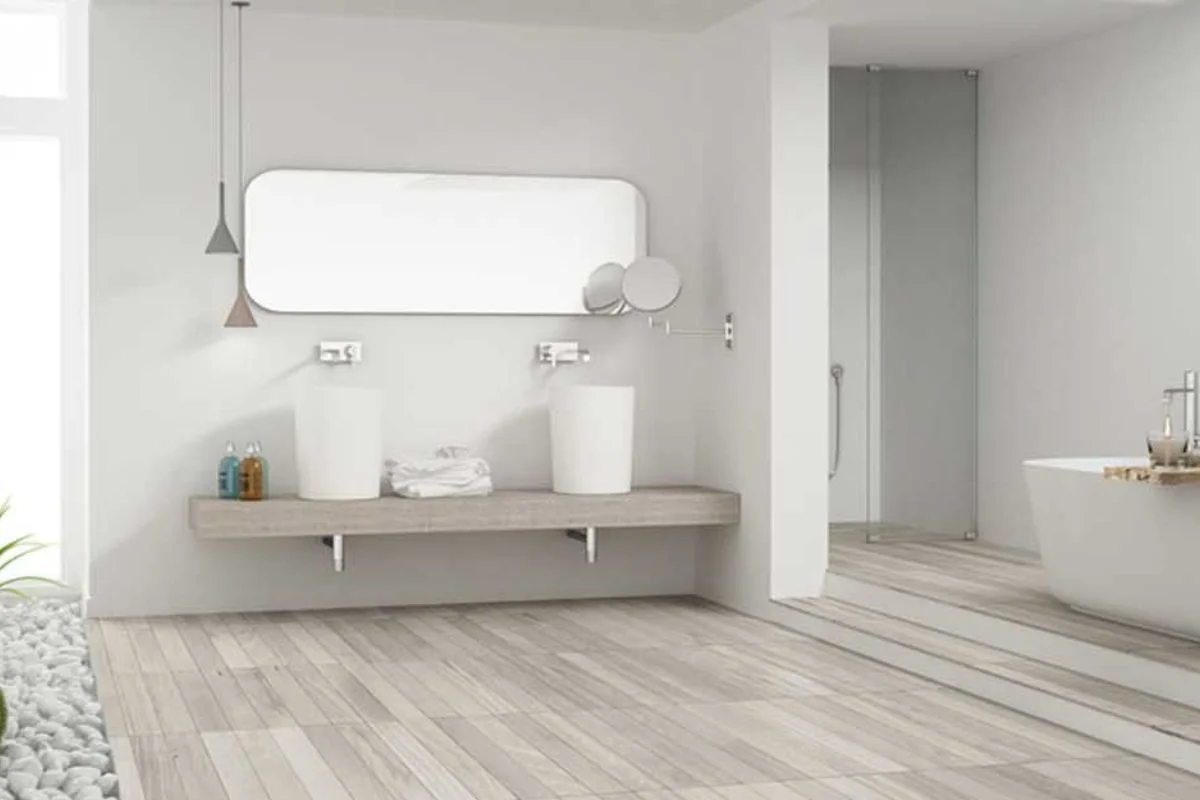Blog
 In the hustle and bustle of daily life, the safety and well-being of our loved ones within the confines of our homes stand as paramount concerns. Every corner, every step, should resonate with a sense of security and comfort. As we navigate through our living spaces, especially in areas prone to moisture or high foot traffic, the risk of slips and falls can pose a significant threat to both young and elderly residents alike.
In response to this crucial aspect of residential safety, the installation of anti-slip flooring emerges as a proactive measure to mitigate accidents and foster a secure environment within the home. Beyond its functional benefits, anti-slip flooring seamlessly integrates into the aesthetic fabric of our living spaces, marrying safety with style.
In the hustle and bustle of daily life, the safety and well-being of our loved ones within the confines of our homes stand as paramount concerns. Every corner, every step, should resonate with a sense of security and comfort. As we navigate through our living spaces, especially in areas prone to moisture or high foot traffic, the risk of slips and falls can pose a significant threat to both young and elderly residents alike.
In response to this crucial aspect of residential safety, the installation of anti-slip flooring emerges as a proactive measure to mitigate accidents and foster a secure environment within the home. Beyond its functional benefits, anti-slip flooring seamlessly integrates into the aesthetic fabric of our living spaces, marrying safety with style.
Definition and Function of Anti-Slip Flooring:
Anti-slip flooring, also known as non-slip flooring, is a specialized type of flooring designed to minimize the risk of slips, trips, and falls by providing enhanced traction and grip underfoot. It incorporates various materials, textures, and surface treatments to increase friction and reduce the likelihood of accidents, especially in areas prone to moisture, spills, or high foot traffic. The primary function of anti-slip flooring is to improve safety and prevent injuries in both residential and commercial settings. By incorporating features that increase traction, such as textured surfaces or coatings, anti-slip flooring helps individuals maintain stable footing and reduces the risk of slipping, particularly in environments where slippery conditions are prevalent. Anti-slip flooring is commonly used in areas such as bathrooms, kitchens, entryways, outdoor patios, and commercial spaces where safety is paramount. It provides peace of mind for homeowners, business owners, and facility managers, knowing that they have taken proactive measures to protect occupants and visitors from accidents and potential liability. In addition to its safety benefits, anti-slip flooring also offers durability, ease of maintenance, and aesthetic versatility. It comes in a variety of materials, colors, and designs, allowing for seamless integration into different interior and exterior environments while enhancing the overall aesthetic appeal. Overall, the definition and function of anti-slip flooring revolve around its ability to prioritize safety without compromising on practicality or style. It serves as a proactive solution to mitigate the risk of slips and falls, creating safer and more secure environments for everyone.Benefits of Anti-Slip Flooring
Benefits of Anti-Slip Flooring:
Enhanced Safety: The primary benefit of anti-slip flooring is its ability to enhance safety by reducing the risk of slips, trips, and falls. The increased traction and grip provided by anti-slip surfaces help prevent accidents, particularly in areas prone to moisture, spills, or high foot traffic.
Protection Against Injuries: Anti-slip flooring helps protect individuals of all ages, including children, elderly individuals, and people with mobility issues, from injuries caused by falls. By minimizing the likelihood of accidents, anti-slip flooring promotes a safer and more secure environment for occupants and visitors.
Reduced Liability: Installing anti-slip flooring can help reduce liability for property owners, businesses, and facility managers. By taking proactive measures to mitigate the risk of accidents, they can minimize the potential for lawsuits, insurance claims, and costly legal expenses associated with slip and fall incidents.
Compliance with Safety Regulations: Anti-slip flooring helps ensure compliance with safety regulations and standards established by building codes, industry guidelines, and government agencies. By incorporating anti-slip features into flooring designs, property owners can meet or exceed safety requirements and create safer environments for occupants.
Versatility and Adaptability: Anti-slip flooring is available in a variety of materials, textures, and designs, offering versatility and adaptability to different environments and applications. Whether indoors or outdoors, in residential or commercial settings, anti-slip flooring can be customized to meet specific safety and aesthetic requirements.
Durability and Longevity: Many anti-slip flooring materials are known for their durability and resilience to wear and tear. They are designed to withstand heavy foot traffic, moisture exposure, and environmental factors, ensuring long-lasting performance and minimal maintenance requirements over time.
Ease of Maintenance: Anti-slip flooring is often easier to clean and maintain compared to smooth or slippery surfaces. Textured materials and coatings are resistant to stains, dirt, and debris, making them simple to clean with regular sweeping, mopping, or pressure washing.
Improved Confidence and Well-being: By providing a stable and secure surface to walk on, anti-slip flooring helps boost confidence and promote a sense of well-being among occupants. Individuals can navigate their surroundings with greater assurance, knowing that they are less likely to encounter slippery or hazardous conditions.
Types of Anti-Slip Flooring
Textured Tiles: Textured tiles are a common type of anti-slip flooring that features raised patterns or textures on the surface to increase traction and grip. These tiles are available in various materials such as ceramic, porcelain, and natural stone, and are suitable for both indoor and outdoor applications.
Rubber Flooring: Rubber flooring is highly resilient and offers excellent slip resistance, making it ideal for areas with high foot traffic or moisture exposure. It provides cushioning underfoot and is available in a range of colors, patterns, and textures to suit different design preferences.
Vinyl Flooring: Vinyl flooring is another popular choice for anti-slip surfaces due to its durability, affordability, and versatility. It can mimic the look of natural materials like wood or stone while offering enhanced traction and easy maintenance, making it suitable for a variety of residential and commercial settings.
Safety Mats and Runners: Safety mats and runners are flexible, portable solutions for creating anti-slip surfaces in specific areas such as entryways, kitchens, and workspaces. These mats are typically made of rubber or vinyl and feature textured surfaces or anti-slip backings to prevent slipping and tripping hazards.
Epoxy Coatings: Epoxy coatings are applied directly to existing flooring surfaces to create a durable and seamless anti-slip finish. These coatings can be customized with various aggregates, such as quartz or aluminum oxide, to provide additional traction and durability, making them suitable for industrial and commercial environments.
Grated Flooring: Grated flooring consists of interlocking panels or tiles with perforated surfaces that allow water and debris to drain away, reducing the risk of slips and falls in wet or outdoor environments. These flooring systems are commonly used in swimming pool decks, locker rooms, and outdoor walkways.
Textured Concrete: Textured concrete is achieved through techniques such as broom finishing, stamping, or etching to create roughened surfaces that improve traction and prevent slipping. Textured concrete is often used in outdoor spaces like driveways, patios, and sidewalks, where moisture and weather conditions can create slippery surfaces.
Anti-Slip Carpeting: Anti-slip carpeting features specialized backing or adhesives designed to prevent shifting or sliding on smooth surfaces. These carpets are commonly used in residential settings, particularly in areas like stairs, hallways, and bedrooms, where added traction is needed to prevent accidents.
Installation Process of Anti-Slip Flooring
Installation Process of Anti-Slip Flooring:
Surface Preparation:
- Begin by thoroughly cleaning the existing flooring surface to remove dirt, debris, and any residues that may affect adhesion.
- Repair any cracks, holes, or uneven areas in the substrate to ensure a smooth and level base for the anti-slip flooring material.
- Apply a primer to the clean and dry substrate to enhance adhesion and promote bonding between the surface and the anti-slip flooring material.
- Follow manufacturer instructions for mixing and applying the primer, ensuring complete coverage and uniformity.
- Depending on the type of anti-slip flooring chosen, follow specific application guidelines provided by the manufacturer.
- For anti-slip coatings or sealants, use a brush, roller, or sprayer to apply an even layer to the surface, taking care to follow recommended coverage rates and drying times.
- If installing textured flooring materials such as rubber, vinyl, or tile, adhere them to the substrate according to manufacturer instructions, ensuring proper alignment and spacing.
- Allow the applied anti-slip material to cure and dry completely before allowing foot traffic or additional installations.
- Follow recommended curing times provided by the manufacturer, which may vary depending on environmental conditions and the type of anti-slip flooring used.
- Once the anti-slip flooring material has fully cured, inspect the surface for any imperfections or areas that may require touch-ups.
- Address any remaining gaps, seams, or edges to ensure a seamless and professional finish.
- After installation, clean the anti-slip flooring surface to remove any dust, debris, or residues left behind during the installation process.
- Use a mild detergent or cleaning solution and a soft brush or mop to gently scrub the surface, taking care not to damage or scratch the newly installed flooring material.
- Establish a regular maintenance schedule for the anti-slip flooring to keep it clean, safe, and in optimal condition.
- Follow manufacturer recommendations for cleaning products and procedures to avoid damaging the surface and compromising its anti-slip properties.
- Periodically inspect the anti-slip flooring for signs of wear, damage, or deterioration, such as peeling, cracking, or discoloration.
- Promptly address any issues or repairs to maintain the integrity and effectiveness of the anti-slip surface and ensure continued safety for occupants.
Maintenance and Care for Anti-Slip Flooring
Maintenance and Care for Anti-Slip Flooring:
Regular Cleaning Routine:
- Establish a regular cleaning schedule to keep the anti-slip flooring free from dirt, debris, and other contaminants.
- Sweep or vacuum the floor surface regularly to remove loose particles and prevent them from becoming embedded in the texture of the flooring.
- Use mild, pH-neutral cleaning solutions or detergents when mopping or scrubbing the anti-slip flooring.
- Avoid harsh chemicals, abrasive cleaners, or acidic solutions that can damage the surface or compromise its anti-slip properties.
- Promptly clean up spills, water, or other liquids to prevent standing water from accumulating on the surface of the anti-slip flooring.
- Use absorbent materials such as towels or mops to soak up excess moisture and dry the floor thoroughly to prevent slips and falls.
- Periodically inspect the anti-slip flooring for signs of wear, damage, or deterioration, such as scratches, cracks, or loss of texture.
- Pay special attention to high-traffic areas, entryways, and areas exposed to moisture or harsh conditions.
- Address any damaged or worn areas of the anti-slip flooring promptly to prevent further deterioration and maintain safety.
- Repair cracks, scratches, or chips using appropriate patching materials or repair kits recommended by the manufacturer.
- Avoid dragging heavy furniture or equipment across the surface of the anti-slip flooring, as this can cause scratches, scuffs, or damage to the texture.
- Use furniture pads or coasters under heavy items to distribute weight evenly and prevent indentations or markings on the flooring.
- If the anti-slip flooring features a protective sealant or coating, follow manufacturer recommendations for periodic reapplication to maintain its effectiveness.
- Reapply sealant as needed to ensure continued protection against stains, moisture, and wear.
- Educate residents, employees, or visitors on proper maintenance practices and safety precautions when walking on anti-slip flooring.
- Encourage the use of appropriate footwear and caution when navigating wet or slippery areas to minimize the risk of accidents.
Conclusion
In conclusion, the care and maintenance of anti-slip flooring play a pivotal role in upholding its effectiveness and ensuring the safety of the environment it serves. As we’ve explored, anti-slip flooring goes beyond its initial installation – it requires a commitment to regular upkeep and proactive measures to safeguard against slips, trips, and falls.




